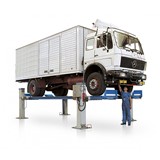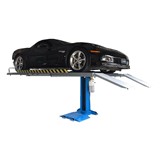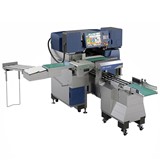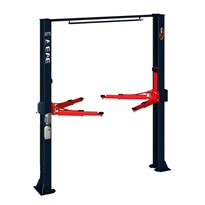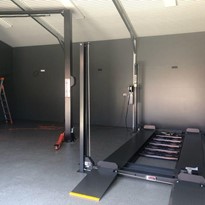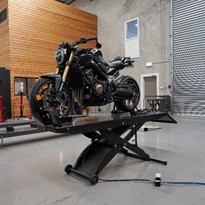A 2 post hoist uses two attachment posts to support the load, which can result in a somewhat imbalanced weight distribution. As a consequence, load sway can be more pronounced, especially when dealing with larger or unevenly shaped loads. This aspect might require more expertise in installation and precise control from the operator to prevent any potential swinging or unintended movements during lifting operations. Additionally, 2 post hoists are often considered for lighter to medium-sized loads and applications where cost-effectiveness and simplicity are priorities. Their relatively straightforward setup and lower cost make them suitable for temporary lifting tasks or environments with space limitations.
On the other hand, 4 post hoists utilise four attachment posts, providing improved load distribution and increased stability compared to their 2 post counterparts. This enhanced stability significantly reduces load sway, allowing for more controlled and precise lifting operations, particularly when handling heavy or delicate loads. With the load weight evenly distributed across four posts, the risk of overloading any single attachment post is minimised, which enhances safety and redundancy. These characteristics make 4 post hoists more suitable for heavy-duty lifting tasks in industries like construction, shipbuilding, and manufacturing, where large loads and intricate operations are common.
While the number of attachment posts is the primary difference, it is important to carefully consider the specific lifting requirements and load characteristics to make an informed decision between a 2 post and 4 post hoist. Each type has its advantages and best suits particular applications, ensuring optimal performance and safety during lifting operations in diverse industrial settings.
Main Differences Between 2 Post and 4 Post Hoists
Number of attachment posts:
- 2 post Hoist: Utilises two attachment posts to suspend the load.
- 4 post Hoist: Utilises four attachment posts to support the load.
Load distribution:
- 2 post Hoist: Distributes the load weight between the two attachment posts, which can cause greater stress on each post.
- 4 post Hoist: Distributes the load weight across four posts, resulting in a more balanced and even distribution of the load.
Stability and sway:
- 2 post Hoist: Tends to be more prone to load sway due to the limited number of suspension posts, especially when dealing with larger or unbalanced loads.
- 4 post Hoist: Offers increased stability, minimising load sway and providing better control over the lifted load.
Control and precision:
- 2 post Hoist: May require more precise vehicle loading and control from the operator to prevent load swing and ensure safe lifting operations.
- 4 post Hoist: Allows for finer control over the load due to its improved stability, making it easier to manoeuvre the load with increased precision.
Safety and redundancy:
- 2 post Hoist: Involves only two attachment posts, which can lead to higher risks if a mechanical failure occurs.
- 4 post Hoist: Offers increased safety and redundancy as the load is supported by four separate attachment posts, reducing the risk of complete system failure.
Load capacity:
- 2 post Hoist: Can handle a wide range of loads, but its capacity might be limited compared to a 4 post hoist, especially for heavier loads.
- 4 post Hoist: Generally has a higher load capacity due to the improved load distribution and increased stability.
Application:
- 2 post Hoist: Suitable for relatively straightforward lifting tasks and smaller loads where limited space, costs and complexity are primary considerations.
- 4 post Hoist: More commonly used for heavy-duty lifting tasks and larger loads that demand higher stability and precision
The main differences between 2 post and 4 post hoists are related to load distribution, stability, control, safety, and their respective applications. The choice between the two depends on the facility characteristics, specific lifting requirements, load sizes, safety considerations, and budget constraints. It is essential to select the right hoist type to ensure efficient and safe lifting operations.
Which Businesses Benefit 2 Post Hoists and What Businesses Benefit From 4 Post Hoists?
The choice between 2 post and 4 post hoists depends on the intended use of the hoist, the specific lifting requirements, load characteristics, and the level of control and stability needed for the lifting operation. Different scenarios and industries can benefit from each type of hoist:
Benefits of 2 Post Hoists:
Intended use: 2 Post hoists allow greater access to vehicle suspensions, wheel service and braking systems.
Cost-effectiveness: 2 post hoists are often more affordable and require simpler installations compared to 4 post hoists, making them a cost-effective choice for certain applications.
Versatility for light to medium loads: They are well-suited for lifting light to medium loads where the load distribution and stability are less critical.
Ease of setup: Due to the lower number of attachment posts, 2 post hoists may be quicker and easier to set up, making them useful for temporary or infrequent lifting tasks.
Space limitations: In situations where space is restricted, a 2 post hoist may be preferred as it requires fewer suspension posts and has a smaller footprint.
Simplicity in operation: While load sway can be a concern, experienced operators can manage the load effectively, making 2 post hoists suitable for tasks where a skilled operator is available.
Industries/Scenarios That May Benefit From 2 Post Hoists:
- Light construction projects
- Automotive workshops
- Tyre retailers
- Car enthusiast garages
- Small-scale material handling in workshops
- DIY projects
- Light maintenance and repair tasks
- Temporary installations
Benefits of 4 Post Hoists:
Load distribution and stability: 4 post hoists offer better load distribution and stability due to the increased number of attachment posts, making them ideal for handling larger, heavy, or unbalanced loads.
Enhanced control: The increased stability reduces load sway, allowing for more precise and controlled lifting operations.
Safety and redundancy: With four separate attachment posts, a 4 post hoist provides increased safety and redundancy.
Handling sensitive or delicate loads: For delicate or sensitive loads that require extra care and control during lifting, a 4 post hoist can be a better choice.
Heavy-duty applications: Industries that frequently deal with heavy loads, such as construction, manufacturing, and shipyards, can benefit from the higher load capacity and stability of 4 post hoists.
Industries/Scenarios That May Benefit From 4 Post Hoists:
- Construction sites
- Automotive workshops
- Tyre retailers
- Car enthusiast garages
- Car storage facilities
- Shipbuilding and shipyards
- Manufacturing facilities
- Mining and extraction operations
- Handling large industrial equipment and machinery
2 post hoists are favoured when cost-effectiveness, simplicity, and versatility for light to medium loads are essential. On the other hand, 4 post hoists are preferred when dealing with heavy loads, requiring enhanced stability, safety, and precise control. The specific lifting needs and the characteristics of the loads being handled will determine which hoist type offers the most significant advantages for a particular application.
How to Choose the Best Provider for Hoists for You
Choosing the best provider for hoists is essential to ensure you get the right equipment, reliable service, and value for your investment. Here are some steps to guide you in selecting the best hoist provider: Tufflift is a international hoist manufacturing and distribution enterprise, hailing from Australia and boasting a collective experience of over 60 years in sales, installation, and service. To meet Australian standards and comply with WorkSafe regulations for the local market, each hoist is meticulously crafted within our network of manufacturing facilities based in China. We place significant emphasis on our commitment to quality, offering an extensive product range, and providing exceptional customer service to assist you in selecting the perfect hoist for your unique requirements.
Assess Your Needs: Before approaching any provider, thoroughly understand your lifting requirements. Consider factors such as facility dimensions including ceiling height, intended use, load capacity, lifting height, frequency of use, and any specific features or functionalities you may need.
Research and Shortlist Providers: Conduct thorough research online, ask for recommendations from industry peers, carefully inspect warranty terms and conditions and check reviews and testimonials. Create a shortlist of hoist providers that seem to meet your needs.
Check Credentials and Experience: Look for providers with a proven track record in supplying quality hoists and related lifting equipment. Check for certifications, industry affiliations, and experience in serving customers with similar requirements.
Product Quality and Options: Evaluate the range of hoists they offer and ensure they provide products from reputable manufacturers. Consider whether they have a variety of hoists, including 2 post and 4 post hoists, and other types to suit different applications.
Customisation and Specialisation: If you have unique requirements, inquire about the provider’s ability to customise hoists to fit your needs. Some providers specialise in specific industries or applications and may have in-depth expertise in those areas.
Safety and Compliance: Safety is paramount when dealing with lifting equipment. Ensure the provider adheres to safety standards and provides hoists that comply with industry regulations and certifications.
Service and Support: Consider the level of customer support offered by the provider. Do they offer installation services, maintenance, and repairs? A provider that offers comprehensive support will ensure your hoists remain in excellent working condition.
Price and Value: While cost is a factor, focus on the value you’ll receive from the provider. Look beyond the initial price and assess the long-term benefits, such as equipment reliability, reduced downtime, and improved safety.
Warranty and Maintenance: Inquire about the warranty period for the hoists and the maintenance options available. A reliable provider should offer a good warranty and maintenance plans to keep your hoists operating optimally.
References and Customer Feedback: Request references from the provider and reach out to their existing customers to gather feedback on their products and services. Positive references can give you more confidence in your decision.
Demonstrations and Trials: If possible, arrange for demonstrations or trials of the hoists you are interested in. This hands-on experience will help you gauge the hoist’s performance and ease of use.
Long-term Relationship: Consider the provider’s willingness to build a long-term relationship with your company. A strong partnership can lead to better support and improved customer service over time.
By following these steps and conducting due diligence, you can choose the best hoist provider that aligns with your lifting requirements and ensures a safe and efficient lifting operation for your business. Or get in touch with Tufflift today, and speak to them about purchasing the correct hoists for your needs.




-160x160-state_article-rel-cat.png)





-160x160-state_article-rel-cat.png)
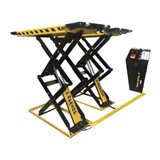


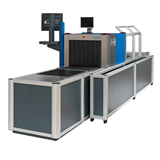


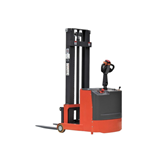
-160x160-state_article-rel-cat.png)
